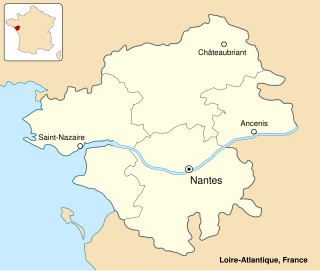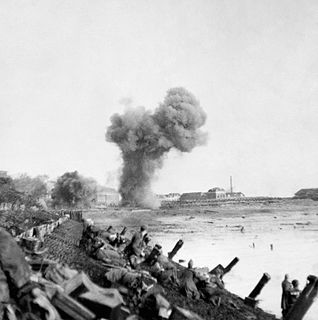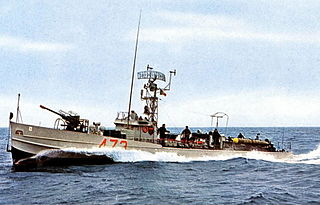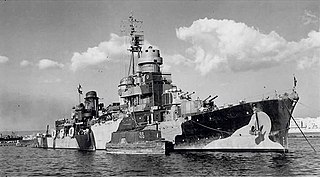
The St Nazaire Raid or Operation Chariot was a British amphibious attack on the heavily defended Normandie dry dock at St Nazaire in German-occupied France during the Second World War. The operation was undertaken by the Royal Navy (RN) and British Commandos under the auspices of Combined Operations Headquarters on 28 March 1942. St Nazaire was targeted because the loss of its dry dock would force any large German warship in need of repairs, such as Tirpitz, sister ship of Bismarck, to return to home waters by running the gauntlet of the Home Fleet of the Royal Navy and other British forces, via the English Channel or the North Sea.

No. 3 Commando was a battalion-sized Commando unit raised by the British Army during the Second World War. Formed in July 1940 from volunteers for special service, it was the first such unit to carry the title of "Commando". Shortly afterwards the unit was involved in a largely unsuccessful raid upon the German-occupied Channel Island of Guernsey.

No. 4 Commando was a battalion-sized British Army commando unit, formed in 1940 early in the Second World War. Although it was raised to conduct small-scale raids and harass garrisons along the coast of German occupied France, it was mainly employed as a highly trained infantry assault unit.

Operation Agreement was a ground and amphibious operation carried out by British, Rhodesian and New Zealand forces on Axis-held Tobruk from 13 to 14 September 1942, during the Second World War. A Special Interrogation Group party, fluent in German, took part in missions behind enemy lines. Diversionary actions extended to Benghazi, Jalo oasis and Barce. The Tobruk raid was an Allied disaster; the British lost several hundred men killed and captured, one cruiser, two destroyers, six motor torpedo boats and dozens of small amphibious craft.

HMS Erebus was originally built as a Royal Navy fireship, but served as a sloop and was re-rated as such in March 1808. She served in the Baltic during the Gunboat and Anglo-Russian Wars, where in 1809 she was briefly converted to a fireship, and then served in the War of 1812. In 1814 she was converted to a rocket vessel to fire Congreve rockets. While serving off America, Erebus participated in the sack of Alexandria, Virginia, and launched the rockets that bombarded Fort McHenry in Baltimore on 13 September 1814. In March 1815, off Georgia, she fired the second-to-the-last-shot of the war. She was laid up in 1816 and sold for breaking up in 1819.

The motor gun boat (MGB) was a small, high-speed British military vessel of the Second World War, which was armed with a mix of guns, in contrast to the physically similar motor torpedo boat (MTB), whose main offensive weapon were torpedoes. The small size of the MGBs, and their high speed, made them difficult targets for German E-boats, though, like their opponents, they were limited by heavy weather, because they did not provide a stable-enough platform to aim the guns. The large number of guns meant the crew was relatively large, numbering as high as thirty men on the largest boats.

HMS Aphis was a Royal Navy Insect-class gunboat. She was built by Ailsa Shipbuilding Company, launched on 15 September 1915 and completed in November 1915. She was based in Port Said at the beginning of World War I, served in Romania and then the China Station until 1940. All of her fighting service was in the Mediterranean, taking part in the invasion of Pantelleria and landings in the south of France, returning briefly to the Pacific in 1945. She was scrapped at Singapore in 1947. Her class was intended for shallow, fast flowing rivers and they also proved suitable for inshore operations when her relatively heavy weaponry could be used to support Army operations.

The harbour defence motor launch (HDML) was a 72 ft (22 m) long British-designed motor vessel used for harbour defence during World War II. Nearly 500 were built by numerous Allied countries during the war.

Operation Infatuate was the code name given to an Anglo-Canadian operation in November 1944 during the Second World War to open the port of Antwerp to shipping and relieve logistical constraints. The operation was part of the wider Battle of the Scheldt and involved two assault landings from the sea by the 4th Special Service Brigade and the 52nd (Lowland) Division. At the same time the 2nd Canadian Infantry Division would force a crossing of the Walcheren causeway.

Coastal Forces was a division of the Royal Navy initially established during World War I, and then again in World War II under the command of Rear-Admiral, Coastal Forces. It remained active until the last minesweepers to wear the "HM Coastal Forces" cap tally were taken out of reserve in 1968. In 2020, 1st Patrol Boat Squadron was restructured as Coastal Forces Squadron encompassing the Archer-class patrol vessels and the Batch 1 River-class offshore patrol vessels and are responsible for UKEEZ Protection and Patrol.

Operation Abstention was a code name given to a British invasion of the Italian island of Kastelorizo (Castellorizo) off the Turkish Aegean coast, during the Second World War, in late February 1941. The goal was to establish a torpedo-boat base to challenge Italian naval and air supremacy on the Greek Dodecanese islands. The British landings were challenged by Italian land, air and naval forces, which forced the British troops to re-embark amidst some confusion and led to recriminations between the British commanders for underestimating the Italians.
The Marinefährprahm (MFP), "naval ferry barge", was the largest landing craft operated by Germany's Kriegsmarine during World War II.
The 4th Special Service Brigade was a brigade-sized formation of the British Commandos formed during the Second World War in March 1944 from battalion-sized units of the Royal Marines. Due to the success of the British Army Commandos' operations in Norway, the Channel Islands, St. Nazaire, and the Middle East, the Admiralty dissolved the Royal Marines Division in late 1942 and reorganized its amphibious assault infantry into eight additional Commando units.
No. 5 Commando was a battalion-sized commando unit of the British Army during the Second World War.
No. 48 Commando was a battalion-sized formation of the British Commandos, formed in 1944 during the Second World War. No. 48 Commando was assigned to the 4th Special Service Brigade and served in North West Europe, taking part in the Normandy landings and operations around Ostend and Antwerp before being disbanded after the war in January 1946.

The invasion of Elba, codenamed Operation Brassard, was part of the Italian campaign during the Second World War. The invasion was carried out between 17–19 June 1944 by Free French Forces supported by British and American ships and aircraft.

The Motosilurante CRDA 60 t was a type of motor torpedo boat built for the Regia Marina during World War II. It was designed on the pattern of German E-boats—some early examples of which were captured by the Italians from Yugoslav Navy—to complement the faster but less seaworthy MAS boats. It was two Motosiluranti CRDA that scored the biggest success by fast torpedo craft in the Second World War, the sinking of British light cruiser HMS Manchester. After the conflict surviving boats remained in service with the Marina Militare—the last ones being ultimately dismissed after almost 40 years of service, in the late 1970s.

Operation Scylla on the night of 17/18 July 1943, during the Second World War was the transit of the Regia Marina Capitani Romani-class light cruiser Scipione Africano. The cruiser sailed from La Spezia in the Tyrrhenian Sea to Taranto in the Ionian Sea during the Allied invasion of Sicily.














